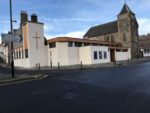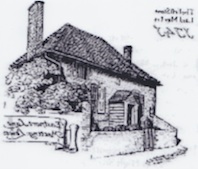
18th century beginnings Since the 1650’s independents have been established in Lewes, and Christians with Baptist beliefs have been active in Lewes since before 1741. In 1780 the independents were in dispute about baptism, and the Baptist faction moved out of Chapel Hill and brought the old Quaker Meeting House for £110 and occupied it while their Chapel was built in Foundry Land.
Our own church began in 1784. They met in a purchased building on Friars Walk. This swiftly proved too small, so the next year they built their own timber-framed meeting house on Foundry Lane.

Within a decade of opening, the church had grown to over a hundred members. Within twenty years the church had opened a second house in another part of Lewes. However the conditions in which the church met were not ideal. The timber building was decaying, their lease was short, and the nearby Foundry was proving a nuisance. So soon after the church’s 30th birthday the old Meeting House was sold and the church moved to its present site on Eastgate Street.
Move to Eastgate Street This first Meeting House on Eastgate Street was converted from an existing house in 1819. No picture is available of this building, but we know that the historic brass candlesticks used to light it were replaced with gas lighting in 1830. This building also swiftly decayed and was going to require a lot of expense in repairs.
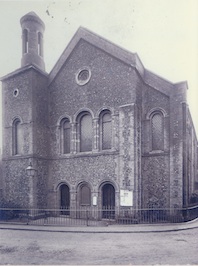
So in 1843 the church moved out, and for five months they met in the lecture hall of the Mechanics Institute in West Street. This enabled the old building to be demolished and the present building to be erected. The opening services were held on October 11th 1843, a day of torrential rain. By the 1840s the church had about 200 members and a Sunday School that added over a hundred more. This was probably the largest the church has ever been. However, the church had incurred a large debt in erecting the building that took more than 30 years to pay, and which seems to have weighed down the church.
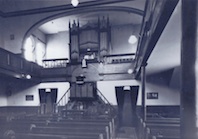
The singing had been accompanied by a harmonium, but in the 1870s an organ was bought from Seaford Parish Church.
Rebuilding and extending In 1890 the building was thoroughly repaired and restored. The interior was repainted, a communion rail was put around the platform, and a new pulpit was built. The pews were remodelled and their doors removed.
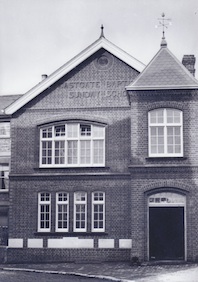
However the Sunday School had outgrown the facilities available. So a building fund was started in 1892, and in 1895 a site was purchased at the corner of Green Wall and Eastgate Street. The new Sunday School building had an imposing square tower and was opened in 1899. The church was still sizeable in the Edwardian era, with over 150 members and 250 in the Sunday School. A new two-manual pipe organ was installed in 1909, and an extension to the Sunday School was opened in 1911.
Two world wars When the church had been erected in 1843, the tower had been given a ‘pepper box’ ornamentation by an individual who “wanted to put something on top of it”. However, by 1915 the old tower had become unsafe because it was not weather-proof and it was suffering from the vibrations of heavy traffic. So the church removed the ‘pepper box’ and rebuilt the upper part into its present pyramid form.
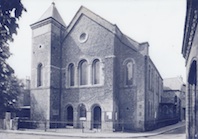
The church took the opportunity to redecorate, retile the aisles, and install electric lighting. Also in 1915 the wife of the minister, Rev J P Morris, suddenly died. In memory of her he presented the church with a beautiful mahogany communion table that is still in use.

The church was no Sundays-only affair. An account of 1934 noted the Sunday school, the Societies of Christian Endeavour (both Junior and Senior), the League of Ropeholders, the Young Worshippers’ League, the Women’s Hour, the Sick Benefit Club, the Boy Scouts and the Girl Guides. In 1937 the church opened its new Jubilee Hall and vestry, at the rear (west) of the church building. This was constructed on a plot of land that had formerly been workshops, and had been bought by the church in 1913. Early in the war a school from Tooting Bec (London) was linked with a school in Lewes, and a group were evacuated to Lewes. Many of the Tooting boys had been in the Boys’ Brigade, and were keen to continue. So the 1st Lewes Company was established at Eastgate, and soon the Girls’ Life Brigade Company were added.
Second half of the 20th century The church has long had an interest in foreign mission. In 1811 the church had recorded that “We cannot but feel ourselves interested in the success of missions to the heathen”, and in 1812 the church had followed the work of the Baptist Missionary Society (BMS) in India. A century and a half later, in 1961, a church member (Jennifer Pell) went out to India with the BMS. Jenny returned in 1974 and is still a church member. The BMS Honorary Treasurer is another current church member, John Howes. During the 1960s Little East Street was rebuilt, and the Sunday School had to be demolished in 1967. A new church hall was built on the opposite (southern) side of the church and opened in 1970.
Nationally, the big decline in church attendance began in the 1950s. At that time Eastgate still had a membership of 130. By 1975 this had declined to the 80s, but has remained relatively constant since, still in the 80s in 2009. Times had changed, and uniformed organisations were no longer popular. So in the early 1970s the Boys’ and Girls’ Brigades were replaced with other youth clubs, the successors to which still run. The Sunday School evolved into TGI Sunday. In 1985 the church started to meet in individual homes once a fortnight, not all at once, but in smaller housegroups. Since about 1990 the use of the church hall has expanded.
21st century
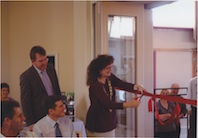
The church gradually realised that there was a gap between the activities in the church hall during the week, and the rest of the life of the church. The fact that the church and the hall were separate buildings was itself an obstacle. So in 2008-09 the Hole in the Wall project knocked large holes in the south wall of the church and the north wall of the hall, thus joining the two buildings together, and helping to integrate the life of the church. The opportunity was taken to refurbish the church interior. The downstairs pews have been replaced with chairs, and the whole area has been carpeted. The interior doorways have been realigned, and glazed outer doors fitted. It is now possible to stand outside the church and see straight through to the pulpit and organ. Technology has changed, and public worship at Eastgate has changed too. The 1909 organ was deemed uneconomic to repair. So an Allen computer organ was added in 1976, but the old organ was left in place. In the last 20 years the church has moved away from using hymnbooks to displaying the lyrics onto screens with projectors. The rear pews were removed in 2008 and and an AV desk was installed.
Eastgate today The church is as alive today as it has always been. The beliefs of the church are basically still those of the founders in the 18th century. It is amazing to think that with all the changes in Lewes and the rest of the world over the last 225 years, and all the generations who have been Eastgate, the heart of the church remains the same. Of course, how we do things is a bit different. We dress a little bit different. We speak a little bit different. But at heart, we are the same. Come along and become part of that shared history!